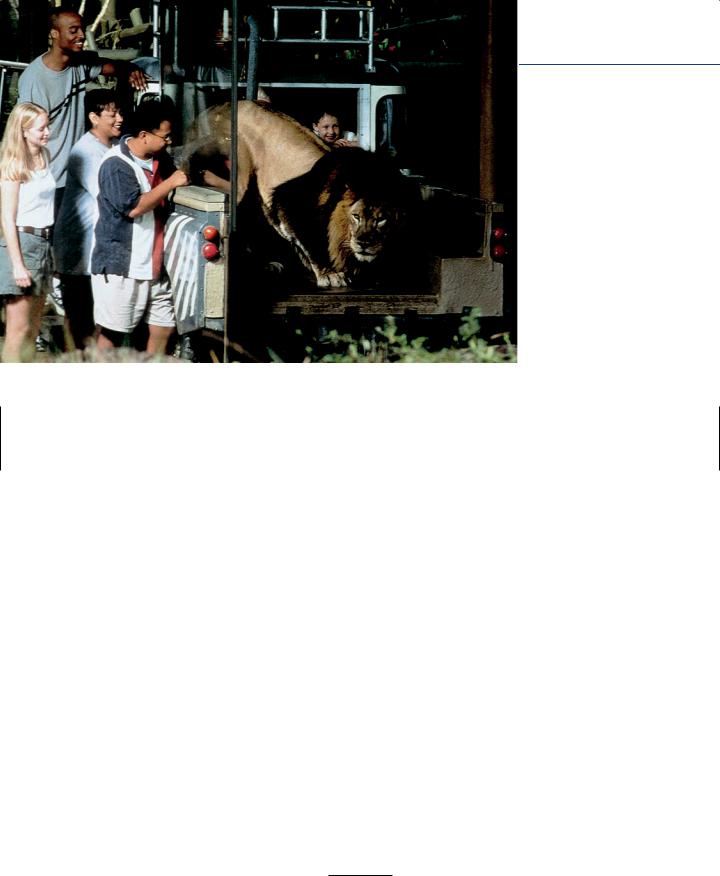
- •CONTENTS
- •PREFACE
- •Content—Benefits for Students
- •Content—Benefits for Instructors
- •Features of the Book for Students and Instructors
- •Supplementary Materials
- •Acknowledgments
- •What Is Hospitality Management?
- •The Manager’s Role in the Hospitality Industry
- •Why Study in a Hospitality Management Program?
- •Planning a Career
- •Employment as an Important Part of Your Education
- •Getting a Job
- •Employment at Graduation
- •The Outlook for Hospitality
- •Summary
- •Managing Change
- •Demand
- •Supply
- •Workforce Diversity
- •The Impact of Labor Scarcity
- •Summary
- •The Varied Field of Food Service
- •The Restaurant Business
- •The Dining Market and the Eating Market
- •Contemporary Popular-Priced Restaurants
- •Restaurants as Part of a Larger Business
- •Summary
- •Restaurant Operations
- •Making a Profit in Food Service Operations
- •Life in the Restaurant Business
- •Summary
- •Chain Restaurant Systems
- •Independent Restaurants
- •Franchised Restaurants
- •Summary
- •Competitive Conditions in Food Service
- •The Marketing Mix
- •Competition with Other Industries
- •Summary
- •Self-Operated Facilities
- •Managed-Services Companies
- •Business and Industry Food Service
- •College and University Food Service
- •Health Care Food Service
- •School and Community Food Service
- •Other Segments
- •Vending
- •Summary
- •Consumer Concerns
- •Food Service and the Environment
- •Technology
- •Summary
- •The Evolution of Lodging
- •Classifications of Hotel Properties
- •Types of Travelers
- •Anticipating Guest Needs in Providing Hospitality Service
- •Service, Service, Service
- •Summary
- •Major Functional Departments
- •The Rooms Side of the House
- •Hotel Food and Beverage Operations
- •Staff and Support Departments
- •Income and Expense Patterns and Control
- •Entry Ports and Careers
- •Summary
- •The Economics of the Hotel Business
- •Dimensions of the Hotel Investment Decision
- •Summary
- •The Conditions of Competition
- •The Marketing Mix in Lodging
- •Product in a Segmented Market
- •Price and Pricing Tactics
- •Place—and Places
- •Promotion: Marketing Communication
- •Summary
- •The Importance of Tourism
- •Travel Trends
- •The Economic Significance of Tourism
- •The United States as an International Tourist Attraction
- •Businesses Serving the Traveler
- •Noneconomic Effects of Tourism
- •Summary
- •Motives and Destinations
- •Mass-Market Tourism
- •Planned Play Environments
- •Casinos and Gaming
- •Urban Entertainment Centers
- •Temporary Attractions: Fairs and Festivals
- •Natural Environments
- •On a Lighter Note. . .
- •Summary
- •Management and Supervision
- •The Economizing Society
- •The Managerial Revolution
- •Management: A Dynamic Force in a Changing Industry
- •What Is Management?
- •Summary
- •Why Study Planning?
- •Planning in Organizations
- •Goal Setting
- •Planning in Operations
- •The Individual Worker as Planner
- •Long-Range Planning Tools
- •Summary
- •Authority: The Cement of Organizations
- •Departmentalization
- •Line and Staff
- •Issues in Organizing
- •Summary
- •Issues in Human-Resources Management
- •Fitting People to Jobs
- •Recruiting
- •Selection and Employment
- •Training
- •Retaining Employees
- •Staff Planning
- •Summary
- •The Importance of Control
- •Control and the “Cybernetic Loop”
- •Tools for Control
- •Summary
- •Leadership as Viewed by Social Scientists
- •Why People Follow
- •Leadership Theories
- •Communication
- •The Elements of Leading and Directing
- •Developing Your Own Leadership Style
- •Summary
- •A Study of Service
- •Rendering Personal Service
- •Managing the Service Transaction
- •How Companies Organize for Service
- •Summary
- •INDEX

Noneconomic Effects of Tourism |
437 |
linked to one or more of the airline systems, the emerging system has literally thousands of instantaneous selling points. More and more of these companies are offering online booking systems to Internet users. As a result, what is emerging is an even more competitive travel marketplace. Offering to book tickets is no longer enough for survival. Travel agents, increasingly, must use the tools of their infor- mation-rich environment and their expertise to provide services to consumers they cannot readily provide for themselves. Although the information revolution is making a great deal possible, it is not necessarily making it easy—and the information environment of travel is becoming increasingly complex. Ultimately, travel agencies and other intermediaries who make it possible for the consumer to choose intelligently from the many options now available will survive. Those who simply book tickets may not.
Noneconomic Effects of Tourism
So far, we have stressed the economic structure and impact of tourism. As we will see, however, tourism has other impacts, both unfavorable and favorable and cer-
tain noneconomic effects.
CROWDING
A successful tourist attraction may, in effect, self-destruct from its own success. One of the major potential problems of tourism is crowding: So many people want to see the attraction that its own success destroys its charm. Many students can probably think of one of their own personal experiences that could support this.
At successful theme parks, this problem is addressed by designing places where guests will be waiting in line as “staging areas,” with interesting views and even live or mechanized entertainment to distract the visitors. Another theme park tactic is to have lots of cleanup help, so that paper, cigarette butts, and other trash never accumulate, thus reducing or eliminating some of the evidence of crowding.
Another example can be found in areas of scenic beauty such as popular national parks, where trails often become more and more difficult as they progress. Most people turn around and return to the parking lot once the pavement ends, and even fewer continue once the unpaved trail actually becomes difficult to follow. In effect, reducing the amenities is a subtle form of rationing; the ultimate example of this is the

Theme parks have been particularly effective at mitigating the effects of crowding through creative strategies. (Courtesy of Busch Gardens Tampa Bay; © 2004Busch Entertainment Corporation.)
wilderness area, where entrance is only on foot or by horse. Difficulty of access can thus reduce crowding. Another reaction to mass tourism and its impact is ecotourism, which is discussed further in the next chapter.
Along with crowding, tourism can result in noise, odors, and pollution. A special form of crowding is the traffic jam. In many areas, tourist traffic has increased but the local infrastructure—roads, bridges, and airports, for instance—has not kept up. The result is traffic overload, causing delays and, in some cases, accidents and injuries as well. The traffic jam is equally annoying to visitors and local inhabitants. This is an especially serious problem in the developing world, where infrastructure was not highly developed in the first place. In the face of exploding traffic, the situation often becomes critical. Not surprisingly, people who live in a tourist attraction area may have mixed or hostile feelings about further development because of their concern for privacy, the environment, or just their ability to get safely to and from home on crowded highways. This can contribute to the love-hate relationship that often exists between tourists and locals.
Another possible impact of crowding is “crowding out.” For example, a beach or other scenic area formerly used by local people may be bought and its use restricted to paying visitors. This has happened on several Caribbean islands and, in some cases, has resulted in the local populace’s becoming unfriendly or even hostile as they found themselves deprived of access to their beaches. This has led, in a number of instances, to sharp clashes between local people and visitors, an unfriendly
438

Golf is becoming an increasingly popular vacation activity. (Courtesy of ClubCorp.)
environment, and a subsequent drop in the number of visitors. Another example, albeit an extreme one, is Mount Everest, where few people travel to (and climb) but that is experiencing the effects of the garbage left behind by trekkers. Because of the extreme weather, garbage can remain intact for decades. There are now policies in place for the removal of garbage.
These potentially unfavorable developments related to tourism give rise to the notion of “carrying capacity,” that is, the idea that an area can accept only a certain
439

GLOBAL HOSPITALITY NOTE 13.2
Volunteer Tourism1
Education and social status have long been motivations for travel, as have pleasure and sightseeing. Since the latter part of the twentieth century, tourists have begun to search for new and different forms of travel other than mass travel. Along with backpacking, adventure tourism, and eco-tourism, volunteer tourism has emerged as a popular type of alternative tourism. Volunteer tourism is often identified with international volunteering, social work, and conservation corps work.
Volunteer tourism generally covers these four major themes: Nature Based, Community Involvement, Learning Experience, and Interaction/Exchange. Volunteer tourism offers an opportunity to participate in various activities, such as scientific research, conservation projects, medical assistance, economic and social development, and cultural restoration. Actual activities can include translating, cooking, cutting wood, curriculum planning, and organic farming. In addition to these activities, the volunteer has an opportunity to take part in local activities and interact further with the community.
Volunteer opportunities cover all regions of the world with Africa, Asia, and Central and South America as some of the more popular locations. The tourism experience can take place in varied locations such as rainforests, conversation areas, developing communities, hospitals, and high schools.
Project duration can range from 1 to 2 weeks, to several months, to 2 years and beyond. According to McGehee and Santos2, although the interactions between volunteers and the locals may not be particularly lengthy, the intensity often makes up for the duration. The fact that volunteers often need to share meals, sleeping areas, training time, and even travel to and from sites suggests that there are many opportunities to exchange information and develop meaningful connections.
The volunteer activities are indeed mutually beneficial, benefiting locals and visitors. While providing much needed community development, tourists themselves experience a direct interaction that creates changes in their values, consciousness, and lifestyle. It has a substantial impact on the personal development of the participants. They often feel empowered, feel that they have made a difference, and often become more confident in their ideas and beliefs. Thus, volunteer tourism can be viewed as a development strategy leading to sustainable development and centering the convergence of natural resource qualities.
Volunteer tourists are usually required to have free time and money to spend on sustainable development efforts. Volunteer tourists usually pay an amount that is more than an average tourist would
number of visitors without being made less desirable as a destination. That carrying capacity can be seen in terms of the physical infrastructure we discussed in an earlier section of this chapter, but the notion extends to social institutions as well.
FAVORABLE NONECONOMIC EFFECTS
Not all noneconomic effects, however, are necessarily unfavorable. Successful tourist destinations can often fuel local pride: Some tourist events, such as festivals
440

expect to pay on a regular holiday to a similar location. Some organizations such as Earthwatch, Community Aids Abroad, and Youth Challenge International (YCI) often provide some international support or sponsorship programs. Information regarding volunteer travel opportunities is relatively easy to locate through student travel agents on the Internet. GoAbroad.com,3 for example, is a leading international education and experiential travel resource. Its directories contain over 25,000 opportunities abroad, including volunteer opportunities.
The volunteer tourism market segment includes tourists from all demographic groups and individual characteristics. High school students and early university students are the major part of the market. This explains why more and more youth development programs are integrated into volunteer programs. The nonprofit YCI, for example, provides the opportunity for over 4,000 17to 25-year-olds from all over the world to work on different projects in over 30 countries. The representatives of its SERR Project were generally college students with an average age of 21 to 22 years old.
A well-designed volunteer program requires collaboration from different tourism sectors (governments, private enterprise, local communities and organizations, conservation, nongovernmental organizations, and international institutions). To enhance the future of volunteer tourism, there is a need for tourism infrastructure, supply-led marketing, and the establishment and monitoring of the carrying capacities (environmental and cultural). Volunteer tourism introduces new business structures, new travel motivations, new experiences, and undeniably a new emerging type of tourist. It requires a people-oriented approach. In the future, it is believed that volunteer tourism practices can move the industry toward more ethical practices, helping to embed these tourists more richly in the local cultures so that they may gain a more thorough understanding of host values and traditions.
1.The information in this note was gathered from: Wearing, S. (2001). Volunteer Tourism: Experiences that make a difference. U.K.: CAB International. This Note was prepared by Novie Johan, Graduate Research Assistant.
2.McGehee, N. G. and Santos, C.A. (2005). “Social Change, Discourse and Volunteer Tourism,” Annals of Tourism Research, 32 (3), 760–79.
3.GoAbroad.com (www.goabroad.com).
and fairs, may even be staged to celebrate some aspect of the local culture. Agricultural fairs, for instance, which draw thousands—and sometimes hundreds of thousands—of visitors, celebrate a region’s agricultural heritage and its favored crops, as well as provide important educational activities such as 4-H meetings and contests.
In other cases, a local tradition may be observed. In a Portuguese community, it may be a blessing of the fishing fleet; in an area where many of German descent live,
441
